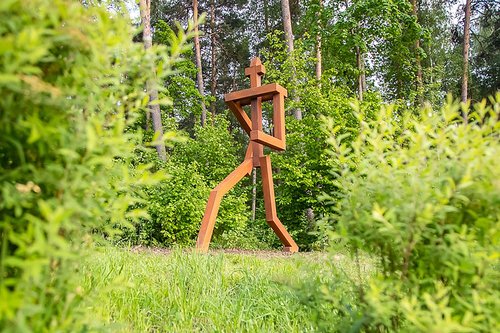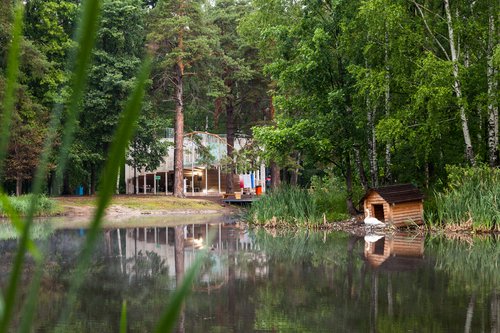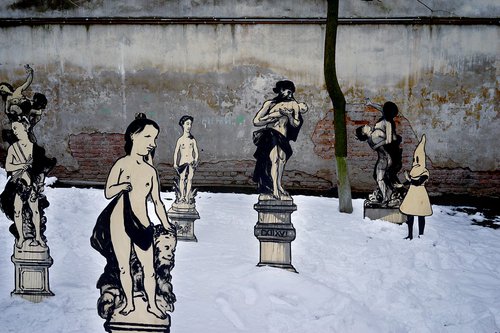Igor Klepnev. SOS, 2022. Les (Forest). Artistic-Therapeutic Trail. Moscow region, 2025. Photo by Daniil Prudnikov. Courtesy of State Historical Museum-Reserve Gorki Leninskiye
Lenin’s Legacy: Contemporary Art in the Forest
A home belonging to the former Bolshevik leader in the countryside outside Moscow is currently the venue for two contemporary art exhibitions. A relaxing artsy retreat for Moscovites wanting to escape the relentless heat of the megapolis, for art critic Mikhail Sidlin, the festive mood was ruined by two plagues: insects and censorship.
‘Forest’ and Sanctuary’ are two contemproary art shows which have just opened in the historic Bolshiye Gorki estate on the outskirts of the Russian capital, giving visitors the unusual opportunity to reflect on the coexistence of contemporary art with the sombre Moscow countryside landscape and turbulent Russian history.
Over the past two decades art festivals and events in the suburbs of Moscow have been popular, starting with ‘Melioratsiya’ which was held in 2002 at the Klyazma River Reservoir. In the mid-2000s, this annual art event, renamed as ‘Art-Klyazma’, attracted both established Russian and international artists from Europe and the USA. The benchmark for such events in the countryside has become Nikola-Lenivets Park, with its regular shows and performances, the most prominent of which is called 'Archstoyanie’ and this year celebrates its 20th anniversary.
Nikola-Lenivets is a village on the Ugra River, more than 200 kilometres from Moscow. Gorki Leninskiye Museum Reserve formely referred to as the Bolshie Gorki estate, lies on the banks of the Pakhra River, approximately 10 kilometres from Moscow’s Ring Road. On a stiflingly hot summer day in Moscow, its proximity to the capital is a great advantage, although in all other respects these two new Moscow events fall short of their historical predecessor ‘Art-Klyazma’, and Nikola-Lenivets.
The basic form of expression in outdoor artistic events is the relationship between the artworks and the landscape. Therefore, the main work of art at Gorki is the ‘Artistic-Therapeutic Trail’, built specifically for ‘Forest’ by young landscape architect Ivan Shchetinin (son of late Vasily Shchetinin, one of the founders of the art community at Nikola-Lenivets). Shchetinin himself has long been one of the active creators of eco-architecture on the Ugra. He designed the complex terrain in the Pakhra surroundings, with its hills and ravines, using a system of walkways and steps that help visitors comfortably walk a few kilometres along a sawdust-covered path that leads past fourteen works of art, with viewing platforms and designer benches placed sporadically at key points. In contrast, in the parts of the ‘Sanctuary’ festival which take place inside the forest, there is no proper path, and viewers have to climb steep and uneven ground or descend along slippery clay soil, cursing and catching their breath afterwards in hammocks or on loungers placed around the damp forest filled with buzzing bloodsuckers.
Gorki Leninskiye is an estate in the Moscow region associated with Vladimir Ulyanov (also known as Lenin), the founder of the Soviet state. Before the October Revolution in 1917, the final lawful owners of this impressive estate were Zinaida Morozova, widow of Savva Morozov, one of pre-revolutionary Russia's wealthiest industrialists and a sponsor of the Bolsheviks, and her third husband, Major-General Anatoly Reinbot. He was mayor of Moscow from 1906-1907 and after a scandalous resignation and until the start of the World War I he lived with Zinaida Morozova in the main house on the estate. Soon after land nationalisation in 1918, Lenin became the ‘lord of the manor’.
Until recently, everyone unanimously deemend the museum at Gorki to be rather boring. However, now there is a new team at the museum that wants to breathe life into it, and appeal to young and trendy urban audiences. Perhaps it is because of this that both art events reference Japanese concepts of shinrin-yoku (“forest bathing”) and wabi-sabi (“humble simplicity”).
An important discovery visitors make of this new summer art location at Gorki is the local ‘uncultivated culturally’ forest. Upon close examination, it becomes clear why. The very possibility of thoughtful, unhurried walks through thickets with dense undergrowth is not questioned by either of the two curatorial groups, different as they are. Although even a brief passage through a landscape densely populated with mosquitoes, ticks, and midges does not require Buddhist unhurriedness, but Orthodox self-denial. “Oh, Russian summer, I would love you, were it not for the summer heat, mosquitoes and flies!” So wrote the poet Alexander Pushkin. Against them, neither forest therapists whose services are offered on the “artistic-therapeutic trail”, nor tea ceremonies in the ‘Sanctuary’ thicket are of any help at all.
Forest is not park. Russia is not Japan. At a stroke, this calls into question both curatorial concepts. In the Summer months, Russians venture into groves strictly on business: for mushrooms, berries, hunting, or collecting deadwood. And they leave home wrapped tightly in tarpaulin, wearing boots and a hat, or even a mosquito net. From afar, the thicket at Gorki appears wild, but once you are inside, it becomes clear that you are surrounded by coniferous-deciduous thickets with windbreaks and other park structures which were abandoned decades ago. There, for example, are many maples. In Russia this is an invasive species, a weed tree that arrived from North America. And by doing a careful study of local hills, searching for burial mounds of the Vyatichi, an ancient Slavic tribe that once lived here, you quickly find only artillery pits that show how in the not so distant past cannons were installed in these Russian jungles, protecting either Lenin or nearby Domodedovo Airport. Two of the artists are even using these pits – as part of the ‘Forest’ exhibition, Danya Pirogov (b. 1996) has placed a plaster creature in one which peers out from a wooden box-cocoon.
The secret of success for an open-air artist is simple: create a work which is maximally connected to the context. Using local storm-fuelled trunks and deadwood, Alexandra Nestyorkina (b. 1990) made a whale skeleton as if a gigantic fossil cast onto an island in the middle of a ravine: unexpectedly, the object appears to grow out of the ravine itself. Her work for ‘Sanctuary’ is an ersatz palm tree made from available materials, planted on neatly mown grass in a meadow which contrasts with wild Russian nature but echoes the history of the conservatory inside the main house at Gorki, which until recently delighted visitors (before its last remaining palms were sadly destroyed by the museum's previous director).
The two art exhibitions may be open at the same time and in the same place, but they are managed and curated by different groups and surprisingly several artists are participating in both such as Alexandra Nestyorkina, Olga Bozhko (b. 1974), and Sergey Katran (b. 1970). Even more curious is that four artist names in ‘Sanctuary’ have disappeared with just the label of the artwork remaining on display, and one of those is popular Russian artist Dmitry Gutov (b. 1960), whose monumental object – аn improvised gong made out of metal sheet which hangs between two concrete poles – is still located in the estate grounds yet without his name. In contemporary Russian practice, ‘damnatio memoriae’ works typically disappear from exhibitions together with artists’ names, but ‘Sanctuary’ has introduced a novel technique where the works remain, but the artists’ surnames have been erased from all printed materials, from the labels and the project website. The contradiction of this technique with Russian copyright law is obviously less scary for curators than confronting the censors. “Of course, censorship is still necessary,” as Lenin used to say. And in 2025 Russia continues to live by Ilyich’s Testament, who loved hunting in the local forest.
Les (Forest). Artistic-Therapeutic Trail
State Historical Museum-Reserve Gorki Leninskiye
Moscow region, Russia
6 July – 28 September 2025
Zapovednoe. Public Art Festival
State Historical Museum-Reserve Gorki Leninskiye
Moscow region, Russia
13 July – 28 September 2025




















